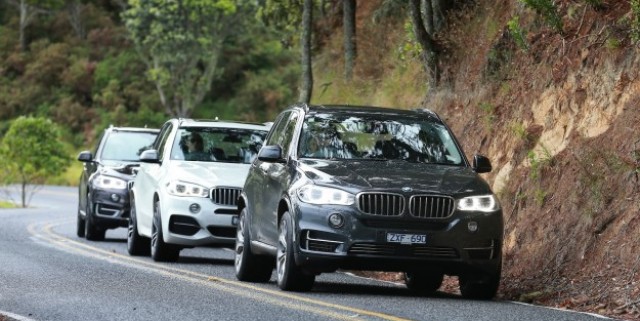
Four-cylinder BMW X5 entry models will join the third-generation Australian line-up for the first time, in $82,900 rear-wheel-drive sDrive25d and $87,900 all-wheel-drive xDrive25d specification.
Although three all-new BMW X5 models go on sale this week – the $99,900 xDrive30d, $133,900 xDrive50i and $147,900 M50d – the twin four-cylinders will arrive in March next year. Their arrival will also coincide with the introduction of the $106,900 xDrive35i and $115,900 xDrive40d.
The BMW X5 sDrive25d weighs 1995kg, where the BMW X5 xDrive30d tips the scales at 2040kg. The latter figure is, however, still 30kg lighter than the new version of the old base model, the BMW X5 xDrive 30d.
Both entry models include a 2.0-litre twin-turbo four-cylinder engine producing 160kW of power at 4400rpm and 450Nm of torque between 1500-2500rpm, and both claim an 8.2-second 0-100km/h. Expectedly, the lighter rear-wheel-drive version is marginally more economical, its 6.8L/100km combined consumption sticker 0.2L thriftier than the heavier all-wheel-drive version.
Standard across the local third-generation BMW X5 range are an eight-speed automatic transmission, auto stop-start technology, 18-inch alloy wheels, leather seats, electrically adjustable front seats with memory, power tailgate, dual-zone climate control, cruise control, front and rear parking sensors with camera, bi-xenon auto headlights, auto wipers, voice control with internet functionality and nine-speaker audio with ‘professional’ satellite navigation and a 10.25-inch screen.
An extra $12,000 for the BMW X5 xDrive30d buys a 190kW/560Nm 3.0-litre turbo-diesel six-cylinder that claims a 6.9-second 0-100km/h and 6.2L/100km combined.
The xDrive30d adds a ‘sport’ mode for the auto, 19-inch wheels, surround view camera, high-beam assistance, ambient interior lighting, extra storage compartments, head-up display, and lane departure warning, forward collision warning and pedestrian warning with city-brake function.
A further $7000 buys the entry petrol model, the BMW X5 xDrive35i of the same capacity as its diesel equivalent, producing 225kW/400Nm and claiming a 6.5-second 0-100km/h and 8.5L/100km combined.
Meanwhile another $9000 sends buyers back to diesel and the same engine as the xDrive30d, which in the BMW X5 xDrive40d produces 230kW/630Nm yet claims identical consumption despite the faster 5.9-second 0-100km/h.
The xDrive35i and xDrive40d share specification, adding 16-speaker Harman Kardon audio, keyless auto entry, sports seats with leather-trimmed dashboard inserts, semi-automatic reverse parking, and adaptive headlights.
Likewise the flagship $133,900 BMW X5 xDrive50i petrol and $147,900 BMW X5 M50d diesel largely add the same gear, the former utilising a 330kW/650Nm 4.4-litre twin-turbo V8 to claim a 5.0-second 0-100km/h and 10.5L/100km combined; the latter a 280kW/740Nm 3.0-litre tri-turbo-diesel six cylinder to claim a 5.3-second 0-100km/h and 6.7L/100km combined.
Both add 20-inch wheels, an alarm, radar cruise control with ‘Stop&Go’ functionality, adaptive LED headlights, four-zone climate control, heated front seats with electrically adjustable lumbar support, and digital radio standard.
Each also differ in the detail, the xDrive50i scoring adaptive suspension ‘professional’ – which incorporates both the $3200-optional ‘comfort’ adaptive suspension with self-levelling rear air suspension optional on all lower models; and the $5800-optional ‘dynamic’ adaptive suspension that further adds active-anti-roll bar optional only on xDrive35i and xDrive40d. The M50d, meanwhile, gets adaptive M suspension which further adds to the latter with firmer Sport and Sport+ modes.
Regular fixed dampers are otherwise standard on sDrive25d, xDrive25d, xDrive30d, xDrive35i, and xDrive40d.
The most prominent among an extensive options list, third-row seating adds $4600 to the price of all X5 models, except the xDrive50i which requires parting with $3200, while the sixth and seventh seats are a no-cost option on M50d.
BMW doesn’t expect the new $83,000-88,000 X5 entry models to cannibalise sales of the X3, as it argues more than half of the mid-sized SUV’s sales are of the entry 20d and 20i models.
The company failed to forecast sales for the twin new X5 models, but noted that 788 of the 2339 sales notched up by its Mercedes-Benz ML-Class main rival to October 2013 were of the entry ML250 CDI. Just as the ML350 CDI is the most popular specification in its range, BMW expects the X5 xDrive30d to maintain the largest sales share in the line-up.
Even without an entry four-cylinder model, the outgoing, six-year-old second-generation BMW X5 has outsold the ML-Class this year, securing 2848 sales which equates to 15 per cent of total BMW sales locally – ahead of the worldwide seven per cent share.





